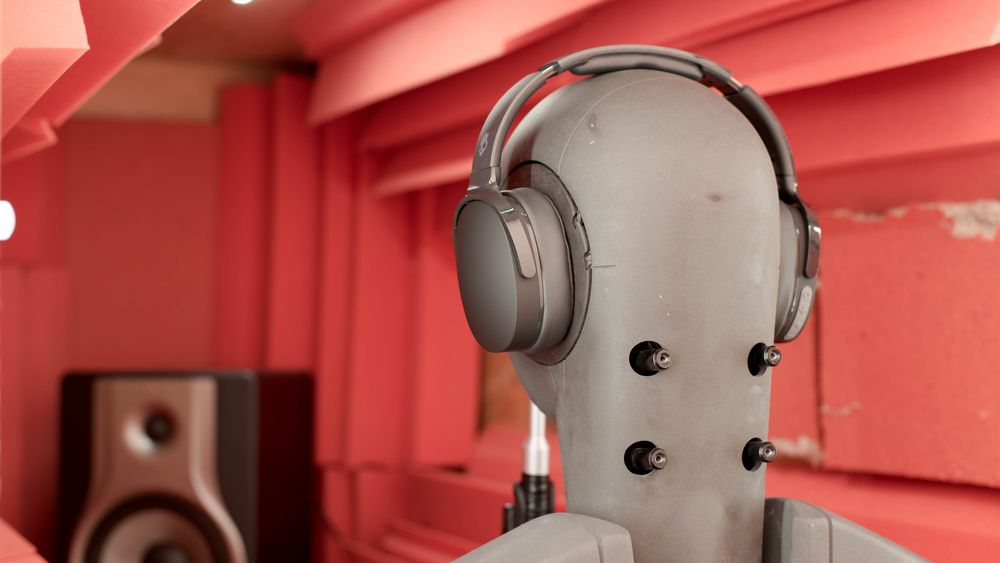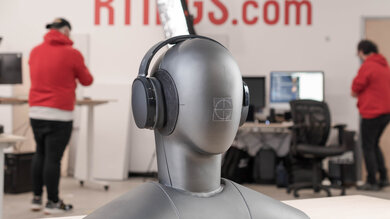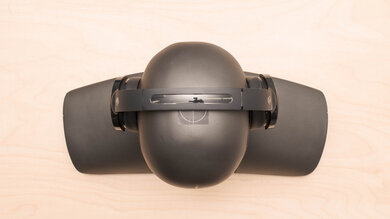The Skullcandy Hesh Evo Wireless are Bluetooth-enabled headphones with a simple design. They offer around 44 hours of continuous playback time, which is a lot more than the Skullcandy Hesh 3 Wireless. They also have an excited, v-shaped sound profile that adds extra boom and thump to your mixes while brightening vocals and lead instruments. However, they lack an EQ or presets to help tweak their sound. They also struggle to isolate noise around you and leak some audio at high volumes.
Our Verdict
The Skullcandy Hesh Evo aren't bad for neutral sound. They have a very excited, v-shaped sound profile so they deliver intense thump and boom, while vocals and lead instruments sound bright and sparkling. While this may be suitable for casual listening, it doesn't sound very neutral, and they lack an EQ to help tweak their sound. There are also slight inconsistencies in bass and treble delivery.
-
Comfortable and stable fit.
-
No EQ.
The Skullcandy Hesh Evo are alright for commuting and traveling. While they're comfortable, they block out very little bass-range noise like bus engines. They're also a bit bulky, which makes them less portable, and they leak audio at high volumes. On the upside, they have around 44 hours of continuous battery life, which should be more than enough for long trips.
-
Outstanding continuous battery life.
-
Comfortable and stable fit.
-
Poor noise isolation performance.
-
Leakage at high volumes.
The Skullcandy Hesh Evo are a decent option for sports and fitness. Although they're a little bulky, which can make them harder to take with you on-the-go, they're decently comfortable and have a stable fit. Since they don't have an audio cable, it's much harder for something to snag them off your head. That said, they may fall off your head during more intense physical exercise.
-
Comfortable and stable fit.
-
Leakage at high volumes.
The Skullcandy Hesh Evo are mediocre for office use. Although they're decently comfortable, they struggle to isolate ambient chatter around you and leak a lot of sound, which may disturb others around you. On the upside, they have around 44 hours of continuous playback time.
-
Outstanding continuous battery life.
-
Comfortable and stable fit.
-
Poor noise isolation performance.
-
Leakage at high volumes.
The Skullcandy Hesh Evo aren't suitable for wireless gaming. They aren't compatible with consoles, and their audio latency on Bluetooth-enabled PCs is likely to be too high for gaming.
The Skullcandy Hesh Evo are a reasonable choice for wired gaming. They have full audio and microphone support with PC, PS4, PS5, Xbox One, and Xbox Series X consoles. They're also comfortable and have an integrated mic that records your voice decently well. However, they don't have a companion app and lack an EQ.
-
Decent recording quality.
-
Comfortable and stable fit.
-
Leakage at high volumes.
-
No EQ.
The Skullcandy Hesh Evo are unremarkable for making phone calls. They have an integrated mic that does a decent job of recording your voice, although it can struggle a bit more in noisy situations like on a busy street. However, the headphones have trouble isolating noise around you, which can make it more difficult to hear what the person on the other end of the line is saying.
-
Decent recording quality.
-
Comfortable and stable fit.
-
Poor noise isolation performance.
-
Leakage at high volumes.
- 6.7 Neutral Sound
- 6.4 Commute/Travel
- 7.1 Sports/Fitness
- 6.2 Office
- 5.2 Wireless Gaming
- 6.8 Wired Gaming
- 6.2 Phone Calls
Changelog
- Updated Nov 15, 2021: Converted to Test Bench 1.5.
- Updated Jan 29, 2021: Review published.
- Updated Jan 25, 2021: Early access published.
- Updated Jan 13, 2021: Our testers have started testing this product.
- Updated Jan 08, 2021: The product has arrived in our lab, and our testers will start evaluating it soon.
Check Price
Differences Between Sizes And Variants
The Skullcandy Hesh Evo come in two color variants: 'True Black' and '92 Blue'. We tested the 'True Black' variant, and you can see its label here. We expect the '92 Blue' color variant to perform similarly overall.
If you come across a different variant, let us know in the discussions so we can update our review.
Compared To Other Headphones
The Skullcandy Hesh Evo are wireless over-ear headphones. They look very similar in design to the Skullcandy Hesh 3 Wireless and Skullcandy Hesh ANC Wireless, as they have a similarly comfortable design and lack a companion app. What sets them apart from others in the Hesh lineup is their longer-lasting continuous battery life of around 44 hours. However, they also lack an active noise cancelling feature and really struggle to reduce noise passively. If you're searching for an alternative, take a look at our list of recommendations for the best over-ear headphones, the best headphones under $200, and the best wireless headphones.
The Skullcandy Crusher Evo Wireless are better headphones for most uses than the Skullcandy Hesh Evo Wireless. The Crusher Evo feel significantly better built and have a more neutral sound profile right out of the box. They also have a haptic bass slider and are compatible with the Skullcandy app, which offers EQ presets. However, the Hesh Evo have a more stable fit and a longer continuous battery life.
The Skullcandy Hesh ANC Wireless are better headphones than the Skullcandy Hesh Evo Wireless. Although both headphones are similarly comfortable, the Hesh ANC have a noise cancelling feature, which helps reduce some ambient noise around you. However, the Hesh Evo have a longer continuous battery life.
The Skullcandy Hesh Evo Wireless are slightly better headphones than the Skullcandy Hesh 3 Wireless. While both headphones have a similar design and sound profile, the Hesh Evo have a better-performing integrated mic, a longer-lasting continuous battery life, and lower latency on iOS and Android.
The Anker Soundcore Life Q30 Wireless are better headphones than the Skullcandy Hesh Evo Wireless. The Anker are more comfortable and better built, and have an amazing active noise cancelling feature. They also have a companion app that offers a graphic EQ and presets and support multi-device pairing and NFC pairing.
The Sony WH-H910N/h.ear on 3 Wireless are better headphones than the Skullcandy Hesh Evo Wireless. The Sony are more comfortable and better built, and have a better-balanced sound profile out of the box. They also have active noise cancelling, which helps reduce some ambient noise around you, a companion app with a graphic EQ and presets, and NFC pairing.
The Skullcandy Venue Wireless are better over-ear headphones than the Skullcandy Hesh Evo Wireless. The Venue are better built, have more consistent bass and treble delivery, and can reduce the ambient noise around you, thanks to their ANC feature. They can also be paired with up to two devices at the same time. However, the Hesh Evo have a longer continuous battery life.
Test Results
The Skullcandy Hesh Evo are fairly conservative-looking headphones. They're styled very similarly to the Skullcandy Hesh 3 Wireless and Skullcandy Hesh ANC Wireless with a sleek satin finish and nondescript ear cups. If you prefer a pop of color, they also come in a blue variant with white padding.
The Skullcandy Hesh Evo are decently comfortable headphones. They have faux leather padding on the ear cups and headband, which feels good on the skin. They're also lightweight and don't clamp too tightly on the head. However, the headband's padding feels a bit thin.
The Skullcandy Hesh Evo have alright controls. All the buttons are found on the bottom of the right ear cup. There are dedicated buttons for raising and lowering the volume. If you hold the '+' button, you can skip the track forward, while holding the '-' button allows you to skip the track backward. You can also press the middle button to play or pause your music as well as answer and end calls. If you press it twice, you can also activate voice assistant. Holding the circle button activates Bluetooth pairing. There are beeps at the minimum and maximum volume as well as audible feedback when you're connected to a device.
The Skullcandy Hesh Evo are fairly breathable headphones. They have a closed-back and over-ear design which doesn't really allow for a lot of airflow. They trap in less heat than the Skullcandy Crusher 360 Wireless, though. That said, if you wear them during moderate physical exercise, you may notice a difference in temperature and sweat.
The Skullcandy Hesh Evo come with a disappointing pouch. It looks and feels silky, which should help keep dust off of your headphones. However, they don't protect from any physical damage. Unlike the Skullcandy Hesh ANC Wireless, it also lacks interior pockets to store your cables.
The Skullcandy Hesh Evo have a just adequate build quality. They have an overall plasticky design with a metal frame running through the headband. There's faux leather padding on the ear cups as well as along the headband. However, they don't feel very dense or durable, so they may be susceptible to damage if they're dropped. They also don't have an advertised IP rating for water resistance, although we don't currently test for this.
The Skullcandy Hesh Evo are stable headphones. They shouldn't come off of your head if you're working at your desk or walking around. However, they could move or even fall off your head if you're wearing them during more intense physical exercise. On the upside, their wireless design makes it harder for something to snag them off your head.
The Skullcandy Hesh Evo have a very excited v-shaped sound profile. They deliver intense thump and boom, while vocals and lead instruments are bright and sparkling. However, some users may find that they sound overwhelmingly bass-heavy and piercing. They also lack an EQ, so you won't be able to tweak their sound.
These headphones have an alright frequency response consistency. There are some inconsistencies in the bass range, and users with thick hair or glasses may especially notice a drop in bass if there's a break in the seal. Treble delivery can also vary due to the positioning and fit of the headphones on your head.
The Skullcandy Hesh Evo have poor bass accuracy. It's very overemphasized across the range, resulting in intense thump, punch, and boom. While some users may prefer this sound, others may find it a bit muddy and overwhelming. However, bass delivery can vary across users, so your experience may vary.
The mid accuracy is excellent. There's some overemphasis coming from the bass range, which can make your mixes sound a bit muddy and cluttered. The rest of the range is fairly flat though, resulting in clear, present, and detailed vocals and lead instruments.
The Skullcandy Hesh Evo's treble accuracy is poor. It's overemphasized across the range, so vocals and lead instruments sound harsh and painful. Sibilants like cymbals are also piercing. Note that treble delivery can vary across users, so your experience may vary.
The Skullcandy Hesh Evo's peaks and dips performance is okay. There's a peak in the high-bass, which adds boom while the dip in the low-mids thins out vocals and lead instruments. Another dip in the high-mids further weakens vocals and lead instruments while a peak in the mid-treble makes sibilants like cymbals piercing.
The imaging performance is very good. There are a couple of minor peaks in the group delay's bass-range, but this can be difficult to hear. That said, the rest of the response falls below the audibility threshold, so the bass still sounds fairly tight while the treble is transparent. The drivers are also well-matched in amplitude and phase response, which are important for maintaining a stable and balanced stereo image. It's also important for accurate localization and placement of objects (voice, instruments, video game effects) in the stereo image. While there is some mismatch in frequency response, it's somewhat minor. These results are only valid for our unit and yours may perform differently.
The Skullcandy Hesh Evo have a mediocre passive soundstage. While the soundstage sounds large and natural, it's perceived as coming from inside your head, rather than from out in front of you. They also have a closed-back design, so their soundstage doesn't sound as spacious as that of over-ear open-back headphones like the Philips Fidelio X3.
These headphones don't have any virtual soundstage features.
The weighted harmonics distortion performance is decent. All frequencies fall within good limits, resulting in fairly clean and pure audio reproduction.
These are the settings we used to test the Skullcandy Hesh Evo. Our results are only valid when using these settings.
The Skullcandy Hesh Evo have poor noise isolation. They don't really block out bass-range noise like bus or plane engines and struggle to cut down mid-range noise like ambient chatter. However, they can help reduce high-pitched noise like the hum of an AC unit. If you're looking for a similar pair of headphones with an ANC feature to help cut down ambient noise around you, try the Skullcandy Hesh ANC Wireless.
The leakage performance is sub-par. A large part of their leakage falls between the mid to treble range, so it sounds a bit thin. That said, if you're listening to your audio at a high volume, people around you can hear it, even in a moderately noisy environment like an office.
The Skullcandy Hesh Evo have an integrated microphone.
The mic's recording quality is decent. Your voice sounds thin but neutral and easy to understand.
The Skullcandy Hesh Evo's noise handling is alright. Although it somewhat struggles to separate your voice from moderately loud background noise, it's best suited for less noisy spaces like at home.
The battery performance is very good. Although they're advertised to have 36 hours of continuous playback time, we measured around 44 hours. However, battery life can vary according to your usage, so your experience may be different. They're also advertised to have a 10-minute quick charge feature, which is supposed to give you three hours of playback time, but we don't currently test this feature. While they don't have a power-saving feature and can't be used while charging, they support passive playback, so you can listen to audio and use their mic while connected via their TRRS cable.
These headphones don't have a companion app.
The Skullcandy Hesh Evo have decent Bluetooth connectivity. While they support Bluetooth 5.0, you can't pair them with multiple devices at the same time or quickly pair your device to these headphones via NFC pairing. They also have slightly high latency on PC. However, their audio latency on iOS and Android is a lot lower, which makes them suitable for streaming video. That said, some apps compensate for latency differently, so your experience may vary.
These headphones don't support any non-Bluetooth wireless connections.
The Skullcandy Hesh Evo are fully compatible with the Xbox One and Xbox Series X when you plug their 1/8" TRRS cable into your controller.
Comments
Skullcandy Hesh Evo Wireless: Main Discussion
Let us know why you want us to review the product here, or encourage others to vote for this product.





























































































